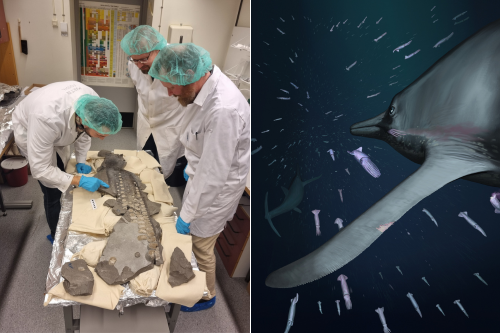
Photograph of Drs Lomax and Lindgren, together with fellow researcher Sven Sachs, examining one part of the flipper at Lund University, Sweden, and an art reconstruction of the giant Jurassic ichthyosaurKatrin Sachs/Joschua Knuppe
A new study has uncovered evidence that a giant marine reptile from the Early Jurassic period used stealth to hunt its prey in deep or dark waters - much like owls on land today.
The research, published today in Nature, investigates a meter-long flipper from a Temnodontosaurus - a giant ichthyosaur – with uniquely preserved with fossilised soft tissues.
The findings reveal that the marine reptile, which exceeds 10m in length, was equipped with evolved to have specialised fins that the scientists believe served to suppress the sound of its own movements when foraging in dimly lit environments about 183 million years ago - an evolutionary adaptation never previously seen in any aquatic creature, living or extinct.
An international team of scientists led by Dr Johan Lindgren from Lund University in Sweden, in collaboration with one of the world's leading ichthyosaur experts, Dr Dean Lomax, an 1851 Research Fellow at the University of Bristol, who has been working on the fossil for about six years.
Dr Lindgren, who has pioneered research on ancient marine reptile soft tissues, said: "The wing-like shape of the flipper, together with the lack of bones in the distal end and distinctly serrated trailing edge collectively indicate that this massive animal had evolved means to minimise sound production during swimming. Accordingly, this ichthyosaur must have moved almost silently through the water, in a manner similar to how living owls—whose wing feathers also form a zigzag pattern—fly quietly when hunting at night. We have never seen such elaborate evolutionary adaptations in a marine animal before."
Although many exceptional ichthyosaurs have been found with soft-tissue preservation, some even with complete body outlines, known soft parts have previously been restricted to a small group of dolphin-sized species. The new discovery is an unprecedented find as it represents the first-ever soft tissues of a large-bodied ichthyosaur. The flipper additionally is constructed in a way never seen before in an aquatic creature, living or extinct, with the crenulated trailing edge being reinforced by novel mineralized, rod-like structures that the team name 'chondroderms'.
Moreover, Temnodontosaurus had the largest eyes – the size of footballs – of any vertebrate known, which lends further support to the hypothesis that this secondarily aquatic reptile hunted under low-light conditions, either at night or in deep waters.
Dr Dean Lomax, who is also a palaeontologist at the University of Manchester, said: "The first time I saw the specimen, I knew it was unique. Having examined thousands of ichthyosaurs, I had never seen anything quite like it. This discovery will revolutionise the way we look at and reconstruct ichthyosaurs (and possibly also other ancient marine reptiles) but specifically soft-tissue structures in prehistoric animals."
The very first ichthyosaur brought to the attention of science was discovered over 200 years ago by pioneering palaeontologist Mary Anning and her brother Joseph. That fossil was also a Temnodontosaurus, the same type of ichthyosaur to which this flipper belonged. "In a weird way, I feel that there is a wonderful full-circle moment that goes back to Mary Anning showcasing that even after 200 years, we are still uncovering exciting and surprising finds that link back to her initial discoveries", added Dr Lomax.
The fossilised flipper was discovered by fossil collector Georg Göltz, a co-author on the new study. Remarkably, Georg made the find entirely by chance whilst looking for fossils at a temporary exposure at a road cutting in the municipality of Dotternhausen, Germany. The fossil consists of both the part and counterpart (opposing sides) of almost an entire front flipper. Although Georg looked for more, no other remains were found. As the top part of the fin is missing, the team surmise that it was originally an isolated flipper that might have been ripped off by a larger ichthyosaur. Georg brought the specimen to the attention of palaeontologist and co-author Sven Sachs of the Natural History Museum, Bielefeld, who recognised the rarity of the find.
"The fact that we are able to reconstruct the stealth capabilities of a long-extinct animal is quite remarkable. Also, because human-induced noise from shipping activity, military sonar, seismic surveys, and offshore wind farms has a negative impact on today's aquatic life, our findings could provide inspiration to help limit the adverse biological effects from anthropogenic input to the modern marine soundscape", says Johan Lindgren.
To unravel the mystery behind the features preserved in this fossil, it was subjected to a range of sensitive imaging, elemental and molecular analyses. The multidisciplinary research team included palaeontologists, engineers, biologists and physicists. This involved high-end techniques such as synchrotron radiation-based X-ray microtomography at the Swiss Light Source SLS at PSI and Diamond Light Source, time-of-flight secondary ion mass spectrometry and infrared microspectroscopy, along with the reconstruction of a virtual model using computational fluid dynamics.
"The fossil provides new information on the flipper soft tissues of this enormous leviathan, has structures never seen in any animal, and reveals a unique hunting strategy (thus providing evidence of its behaviour), all combined with the fact that its noise-reducing features may even help us to reduce human-made noise pollution. Although I might be a little bias, in my opinion, this represents one of the greatest fossil discoveries ever made", added Dr Lomax.
Paper
'Adaptations for stealth in the wing-like flippers of a large ichthyosaur' by J.Lindgren et al in Nature






